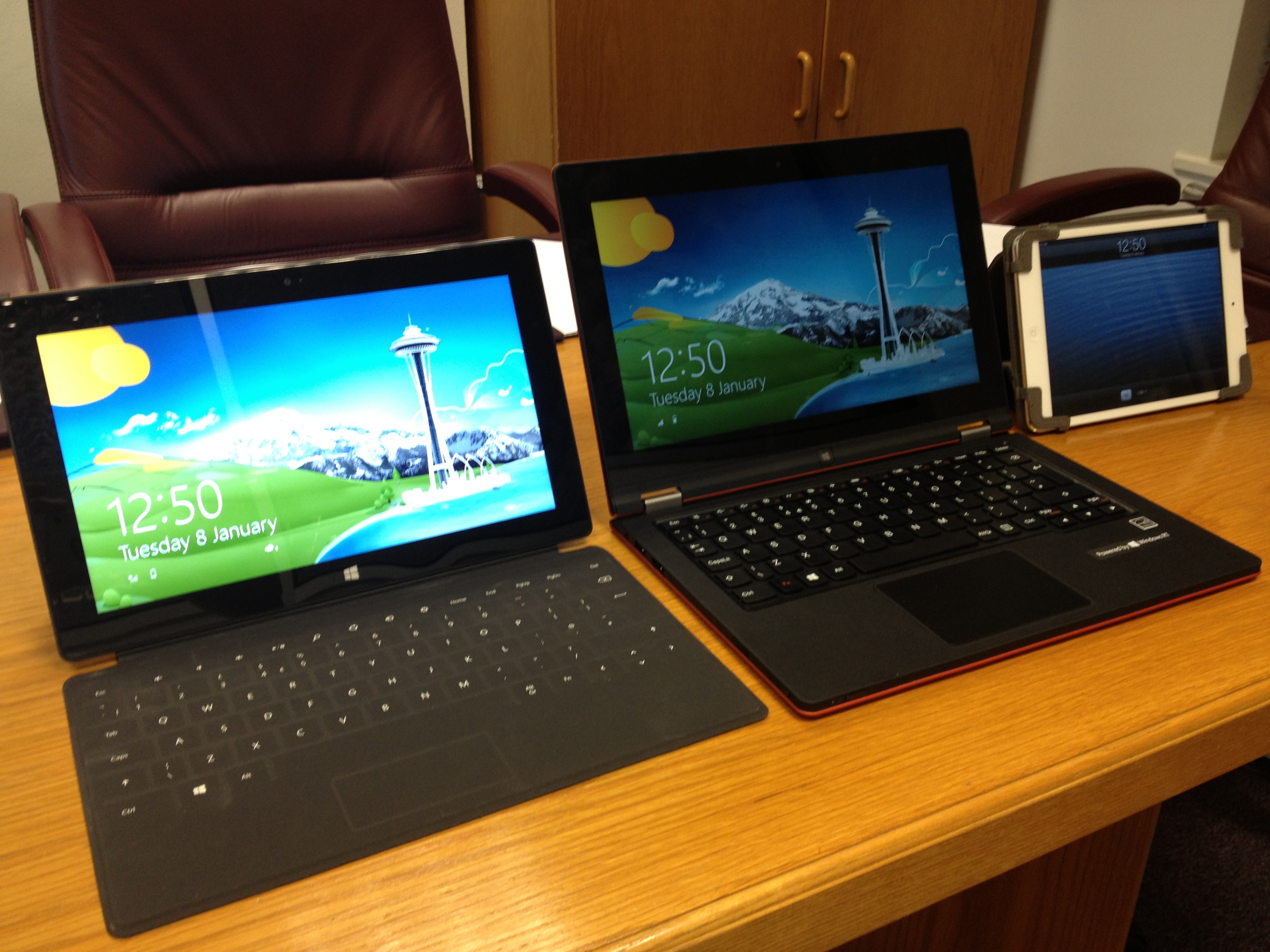Lenovo's IdeaPad Yoga 11 continues to prove that Windows RT is pointless


I don't do many device reviews, because up until this point I only ever write about products that I've actually bought.
However, towards the end of last year I wanted to try a hybrid tablet/laptop and a combination of me being a little too cheap to risk the spend to see what one was like, and the fact that they were a little thin on the ground, I pinged Lenovo and asked if I could try one. This week they lent me one.
It may be the last device they ever lend me…
Yoga
What they sent me was an IdeaPad Yoga 11. This a Windows RT device, and it's one Lenovo's devices with a trick hinge that lets you configure it as a normal clamshell laptop, or fold the screen back into a tablet. It also lets you put it another couple of modes -- either in "tent" mode where you prop it up like a presentation binder, or in "stand" mode which is where you flop the keyboard, keys down, onto your desk. Lenovo claims that this is "endless fun".
(You may care to note that at CES this week Lenovo announced the IdeaPad Yoga 11S, which runs full-on Windows 8 as oppposed to Windows RT.)
The only positive thing I can find to say about this device is that hardware-wise, it's beautiful. It's a great colour, it's nicely made, and it feels good. The keyboard is a little bouncy, but it's nice enough to type on.
Specification-wise, it's roughly the same as as Surface. Both have the same Nvidia Tegra system-on-a-chip running at the same speed. Both have a 64GB storage, and 2GB RAM. But I'm not really one for specs and when you get through the next bit I suspect you're not going to care much about the specs either.
The real problem is the price. In the UK, PC World, John Lewis, and Amazon sell this thing for £700. In US dollars, that's $1,120.
Admittedly, it's a little cheaper in the US -- Amazon US are selling the Yoga for $750. But that's still $51 more than the equivalent "Surface with Windows RT". In the UK, thanks presumably to import duty, the premium for the Yoga over Surface is a whopping 20 percent.
(To make things less confusing to the majority of my readers I'll use US pricing from this point, but please do bear in mind just how ridiculously expensive this device is in the UK.)
Anyway, remember this is a Windows RT device, so you can't run normal Windows software on it. It comes with Office like all Windows RT devices do. And you can download apps from the Windows Store. Personally I think the Windows Store has decent enough app coverage and you can certainly be productive on the Yoga, but it's hard to look at this as a device with limited software support that costs way, way more than a normal Windows laptop.
Hang on though -- what actually is this thing? Is it a tablet or a laptop? Lenovo describe it was both.
It can't be a tablet because it weighs too much. It comes in at 1190g (2.6lbs). (For comparison, an iPad mini with silicon case weighs 376g -- meaning a stack of about three of them weigh the same as the Yoga.) It's also massive -- much, much bigger than a Surface, and you can comfortably fit two iPad minis within its footprint. In tablet terms, it might as well have the same mass as a small star as both factors of size and weight render the device impractical in this mode.
The reason why I originally reached out to Lenovo was that I wanted to try and hybrid tablet was to see what that form factor was like. What I've learnt from this exercise is that it's pointless. An 11" hybrid tablet is too big and too heavy to be used as a tablet. The weight is impractical as you just get physically tired holding it. The size also militates against it being a useful tablet -- you can't grip it on either side and actually reach more than 50 percent of the screen. Of course, when you try and hold it with one hand and then jab at the thing you want with a finger on the other, you end up being reminded that the whole thing is too heavy. In short -- I'd wager that if you bought this or any other hybrid of similar size and weight, you'd use it as a tablet once for about ten seconds before reverting to using it exclusively on a desk or lap.
I should say though that there are, I imagine, some limited uses in commercial or light-industrial environments where a hybrid offers some advantages but in domestic environments as a tablet it's a disaster.
There's another weird problem with hybrids. When you fold the keyboard back under the screen, when you lift up the device like a tablet your fingers mush the keys. I tried this on a few people and each of them panicked the first time they did this. This included both non-technical people, and highly-skilled technicians who knew it was flat-out illogical to have the keyboard active in this mode. Incidentally I have the same problem with my Surface and Type Cover -- each time I pick it up with the keyboard folded back I have a "yuck" moment. It's feels utterly unnatural and fundamentally wrong to be mashing the keys on a keyboard in an uncontrolled fashion.
The nastiest problem though is try showing your four-year-old daughter how you can fold the screen back. Then watch in horror as she tries the same move with your MacBook.
Windows RT
Whatever you think of Windows RT, the biggest problem with it is that it's not Windows. We all know that you can't run Windows software on it, but the only Windows RT devices that you can buy are very, very expensive compared either to the iPad, or an Android tablet, or a cheap Windows 8 laptop.
Here's a strange one though -- every time I think about about the market position of this product, I keep thinking about Chromebooks. The Samsung ARM Series 3 Chromebook feels an awful lot similar to the Lenovo -- same sized screen, similar processor, same amount of RAM and importantly it's more-or-less exactly the same weight. The only thing you don't get is a touchscreen or the trick hinge that purports to turn it into a tablet.
But that Samsung Chromebook has a list price of only $249, a stunning 67 percent cheaper than the $750 Yoga. To reiterate -- that's one third of the price. They also seem to be selling so well on Amazon that you can't buy them at list price -- they're actually commanding a premium.
I suspect I'm going to attract a lot of flak for likening Windows RT to Chromebooks, but someone's really going to have to explain to me why these two aren't essentially the same thing. Neither of them are PCs, but are both an experiment in reframing the PC. Both of them are severely limited in what you can do with them compared to the PC. Any other differences that you can point to are likely incidental with both devices being defined more by what you can't do with them as opposed to what you can.
There are in fact only two major differences between the Chromebook and Windows RT -- one needs an internet connection available to be useful, and one can run Office natively.
Remember at this point you've got a price-differential of $501 to play with. Then consider the last time you didn't have an available internet connection (I'd wager it's unusual that you typically don't have an available internet connection), and also take a look at just how good the web-based version of Office is. Spoiler: it's fantastic. $501 buys a lot of compromise.
Are you honestly telling me that you want to spend $501 on a hinge, because to me that's the only difference between a dirt-cheap Chromebook and the staggeringly expensive Yoga that I can see. OK, so the Yoga has a touchscreen -- a) touchscreens only add $40 to the bill of materials on a screen that size, and b) give it a year and every laptop will have a touchscreen including all Chromebooks. Touch is FTW.
Conclusion
I'm always looking for products that move the story on. It's for this reason alone that I'm so keen on the iPad. The introduction of that product changed things. It made some things better, and it made others worse -- but most importantly it was about something.
Windows RT falls foul of that most dreadful crime committed by technologists -- it's a solution that's looking for a problem. Whilst I was already disappointed with the Surface, I was hoping that the Yoga might focus the Windows RT proposition on something new and exciting. It fails to do that in every regard and all I do is find myself reaching for my coffin nails and coffin hammer. Windows RT is a pointless curiosity with zero market potential and no future at this price point. Bring that price down to the same as Android tablets and Chromebooks and we'll talk.
In summary then, unless you can point at a proper commercial business case to buy a Lenovo IdeaPad Yoga 11, you're wasting your money. If you don't want to buy a normal PC, there are plenty of options out there. Buy an iPad, or an Android tablet, or a Chromebook. And then buy yourself a nice treat with the hundreds and hundreds of dollars you'll save.
What do you think? Post a comment, or talk to me on Twitter: @mbrit.